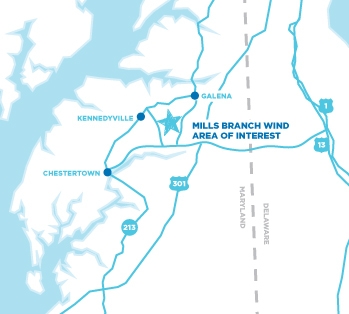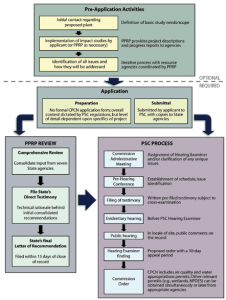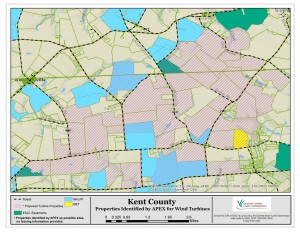Mills Branch Wind Project
Apex Clean Energy, an industrial wind turbine energy developer headquartered in Charlottesville, Va., is proposing to locate 25 to 35 500-foot industrial wind turbines near Kennedyville, Md., between state Route 213 and the Chester River.
What is ESLC’s Position?
ESLC believes local energy generation, especially renewables, is a critical component to the Eastern Shore’s future economic resilience and prosperity. However, the proposed Mills Branch Wind Project is of a scale never before considered on the Eastern Shore and lacks the local public review process necessary to balance our need for renewable energy generation with the impacts of a project this scale. For these reasons and the potential impact on conserved lands, ESLC opposes the Mills Branch Wind Energy Project.
The Eastern Shore has the potential to be the undisputed leader in Maryland renewables, but it can’t be done without thoughtfully balancing the expense to resources like tillable acreage, wildlife habitat, rural vistas and more. ESLC would like to use the attention surrounding the Mills Branch project as a call to action. This region needs to develop a strategy to say “yes” to renewables, but on its own terms.
What will Mills Branch Look like?
According to Apex Clean Energy, their goal is to produce up to 130 MW of wind energy expected to power more than 30,000 homes each year. They are projecting 35-45 wind turbines with turbine height roughly 550 feet. The Mills Branch Project would be located on approximately 5,000 acres of open farmland in Kent County, with the intention of active farming underneath.
How does the project get approval?
The Mills Branch Project needs to get a Certificate of Public Convenience and Necessity (CPCN) from the Public Service Commission. The Public Service Commission regulates gas, electric, telephone, water and sewage disposal companies and the construction of generating stations. Apex will apply for a CPCN and a hearing will be held to determine if the Public Service Commission will grant the application. During the hearing testimonies and briefs from the Power Plant Research Program of the Department of Natural Resources and the Office of People’s Counsel will be heard and used in the decision making process. There has not been any formal filing by Apex for the Mills Branch Wind project with the Public Service Commission as of this date.
What is the PSC process?
ESLC reached out to the PSC to gain insight into the process Apex would have to go through to get the Mills Branch Project approved:
- In advance to filing for a Public Convenience and Necessity (CPCN) from the PSC a significant amount of study and planning will need to be done by Apex.
- Apex must offer the electric utility with the transmission lines serving the areas at least 90 days before the filing of a CPCN and opportunity to construct the generation lead lines from the project.
- At least 10 days before the filing of an application for a CPCN Apex must notify the PSC that the electric utility had declined to construct the generation lead line, or provided a written response to that effect to the company.
- No construction of an overhead transmission line of a capacity over 69 KV may begin before the PSC has issued a CPCN for the project
Once Apex files an application for a CPCN with the PSC, the Commission will immediately:
- Provide notice of the application to the Maryland Department of Planning
- Provide notice of the application to the governing body or municipal government in which any portion of the generation station, overhead transmission line or qualified lead line is situated
- Provide notice of the application to the governing body or municipal government within a mile of any portion of the generation station, overhead transmission line or qualified lead line will be situated
- Provide notice of the project to each member of the General Assembly representing the county in which the project is proposed to be constructed
- All other interested persons; (This is likely to be the affected property owners adjacent to the construction sites for each of the turbines, and others that will have their views impacted by the turbine installations.)
- The Department of Planning will forward the application to each State agency that is required to review aspects of the project and to provide a position on the project.
- The County governing body or municipal will make a determination if the project meets the requirements for construction based upon county zoning and building codes.
Next, the PSC will hold a public hearing jointly with the local governing county government over the property where the construction is to take place, though local government officials may also decline to participate. In addition, there will be an opportunity for the public to comment at a public comment hearing that will be scheduled in the area where the construction is to take place, after advertising in four consecutive weekly editions of local news media of the hearing dates.
After the hearing the PSC will render a decision after due consideration of the recommendations from the various state agencies required to provide input to the Commission, the recommendation of the governing body, and the comments of the public recorded during the public comment portion of the proceedings.
What are the current guidelines for renewable energy in Kent County?
In 2010 the Kent County Renewable Task Force did research to come up with recommendations for renewable energy in Kent County, they looked at wind, solar, geothermal and biomass. Using data from the US Department of Energy’s National Renewable Energy Laboratory it was determined there was not sufficient wind in the area to justify utility scale wind farms, based on this data and other reasons the task force determined utility scale wind energy is not a feasible or desirable option for Kent County. The Task Force did decide that small wind energy systems could be a valuable addition to Kent Count and would serve as a reliable and relatively inexpensive source of electricity. They suggested an 80 foot height limit and in special exceptions a 120 foot height limit.
Talbot County addresses the growing interest in renewable energy in their Comprehensive Plan where they have chosen to apply the existing zoning code to some aspects of wind generation systems. It states that turbines can be up to 160 feet tall and factors like visual aspects must be taken info the consideration.
For many counties there are not set guidelines on wind energy. With renewable energy becoming more frequent on the Eastern Shore guidelines will need to be created.
What are the MALPF guidelines on wind energy?
Currently The Maryland Agricultural Land Preservation Foundation (MALPF) allows wind and solar energy for on farm use. In 2014 legislation was passed to allow large-scale renewable energy on MALPF easements under certain conditions. The regulations are currently being worked on by MALPF and until they are finished they will not approve any projects.
The current MALPF regulations allow wind projects if the total facilities it takes to operate occupies no more than 5% or 5 acres, whichever is less, of the easement property. The location and height of the turbines must be a set distance from the Patuxent River Naval Air Station so they do not interfere with radar.
What Happened to Senate Bill 938?
In response to the Mills Branch project Senator Hersey submitted SB 938 Public Service Commission – Certificate of Public Convenience and Necessity – Land-Based Wind Generating Stations in Kent County the intent of the bill is to move some of the authority to approve the project from the Public Service Commission to the Kent County Commissioners. It prohibits the Public Service Commission to approve Apex’s application for a CPCN until the County Commissioners have approved construction of the projects generating station. The bill was heard in the Senate on April 7, a large crowd turned out to testify in support of the bill including a representative from ESLC. The bill did not make it through, being submitted so late into the session it had a slim chance of making it through and some members of the Finance Committee voiced concern that approving the bill might set a precedent of local authority usurping the PSC. In the wake of the hearing, chairmen of the Senate Finance and House Economic Matters committees plan to cosign a letter to the PSC, asking for a review of the CPCN process. According to Senator Hersey the chairmen want to know to know more about the actual extend local authority has in the PSC process.
Where will the wind turbines be?
This map shows the proposed areas of the turbines in relation to ESLC, MALPF and MET land easements.
NEWS
- Yes to renewables — on Shore’s terms (Star Democrat 4/15/2015)
- Wind bill fails to get out of committee (Kent County News 4/15/2015)
- What will renewable energy look like on the Shore? (The Queen Anne’s Record Observer 4/15/2015)
- Crisfield may get wind turbine this year (Daily Times 4/3/2015)
- News Commissioners hear ESLC concerns on wind (Kent County News 4/2/2015)
- Interim WC President Jay Griswold Slams Apex Wind Project (Chestertown Spy 4/2/2015)
- A Q&A with Apex (Kent County News 4/2/2015)
- Hershey Plans For Kent Wind Hearing (Chestertown Spy 4/2/2015)
- Company eyes farmland for wind turbines (MyEasternShoreMd 3/26/2014)
- Letter to Editor: Are Industrial Wind Turbines Coming To Kent County? (Chestertown Spy 2/26/2015)
- New bill targets wind turbines (3/06/2015 SoMdNews)
- Wind farm opposition growing (MyEasternShoreMD 3/19/2015)
- Wind farm opposition building steam (3/25/2015 MyEasternShoreMD)









